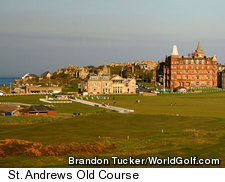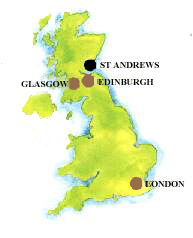 GOLF DESTINATIONS
GOLF DESTINATIONS
St. Andrews, Scotland
St. Andrews is probably eastern Scotland's most beautiful jewel. Replete with history and said to be the resting place of the relics of St. Andrew, this small town can rightly claim to be the center of the nation's educational and religious pasts.
The historical glories of St. Andrews have created a modern and vibrant town economically and culturally indebted to its past. Dating mainly from the 16th century, St. Andrews Castle is situated 800 yards east of the Links on a rock overlooking the North Sea. Its chequered history tells of much Scottish building, English capture and dismantling and Scottish recapture and rebuilding. Although its importance diminished after the Reformation, it remains one of Scotland's most significant buildings.
|
Beyond the castle are the ancient remains of the cathedral, which is the largest religious building ever constructed in Scotland. Founded by Arnold, Abbot of Kelso in 1160, this cruciform church witnessed the most profound developments of the Scottish Reformation and remains among the most photogenic of Scotland's churches.
Dating form Pope Benedict XIII's reign in the 15th century, St. Andrews University is the oldest educational establishment in the country. Despite undergoing a relative decline after the 1707 Act of Union, the university rallied during the commercial heyday of the 19th century and now houses over 4000 students in a centre of international repute.
Just across the road from the Royal & Ancient Clubhouse is the British Golf Museum, whose hands-on, modern facilities (it was built in 1990) bring the game alive in award-winning surroundings and informative exhibits.
Castle Street leads into Market Street whose cobbles support the Lammas Market, the oldest surviving medieval market in Scotland, held each year on the second Monday and Tuesday in August. St. Andrews is an attractive fishing port and a favourite beach resort. Its size and layout of streets and wynds make it an accessible town to explore and discover that golf is only part of its rich tapestry.
Getting to St. Andrews, Scotland
St Andrews Links is on the North East corner of the Fife region in Scotland.
By Car
From Edinburgh: Take the A90 over the Forth bridge (toll bridge) which connects to the M90. Continue north until junction 8 and take the A91 following the signs to St Andrews. Journey time is approximately one hour.
From Glasgow: Take the M8 towards Edinburgh, and turn onto the M80 (Stirling) at junction 13. Continue on the M80 /A80 /M876 to the Kincardine Bridge. Take A977 to M90. Exit M90 at Junction 8 and follow A91 into St Andrews. Journey time is approximately 2 hours.
Airports at Glasgow and Edinburgh offer plenty of connections both nationally and internationally. Car Hire is available from the major firms at both airports and in the city centres.
By Train
St Andrews does not have its own train station. Instead visitors should get off at Leuchars station and get into St Andrews either by bus or taxi. The journey time is approximately 10 minutes.
St. Andrews Golf History T imeline, 1400-1800
imeline, 1400-1800
1123 King David gives links land to the people of St Andrews.
1400s Golf first played on St Andrews Links.
1457 Golf forbidden by Act of Scottish Parliament (James II)
1471 Ban repeated (James III)
1491 Ban repeated (James IV).
1502 James IV takes up golf and buys his first golf clubs
1552 Archbishop John Hamilton given permission by the burgh to establish a rabbit warren on the links. The charter confirms the rights of townspeople to play golf over the links
1583 Two St Andrews boys rebuked by Kirk Session for golfing on Sabbath.
1611 Archbishop Gladstanes grants a contract confirming Hamilton's charter
1614 Gladstanes grants a charter confirming his contract
1620 James VI grants a charter ratifying Gladstanes' contract and charter.
1726 William Gib granted permission to put rabbits on the links, with a proviso that the golfing area must not be damaged
1754 Society of St Andrews Golfers founded
1764 Standard round of golf established at 18 holes
1769 Exchange of land between Laird of Strathtyrum and Town Council, with a condition that the golfing area is not to be ploughed up or enclosed
1771 Fees of caddies fixed
1797 St Andrews Town Council reported to be in financial difficulty. Robert Gourlay and John Gunn advance money to the Town Council on the security of the links
Gourlay and Gunn exercise their right to sell the links by disposing of part of the land to Thomas Erskine of Cambo
1799 Links sold to Charles and Cathcart Dempster, who introduce rabbits on a commercial scale.
Any opinions expressed above are those of the writer and do not necessarily represent the views of the management. The information in this story was accurate at the time of publication. All contact information, directions and prices should be confirmed directly with the golf course or resort before making reservations and/or travel plans.